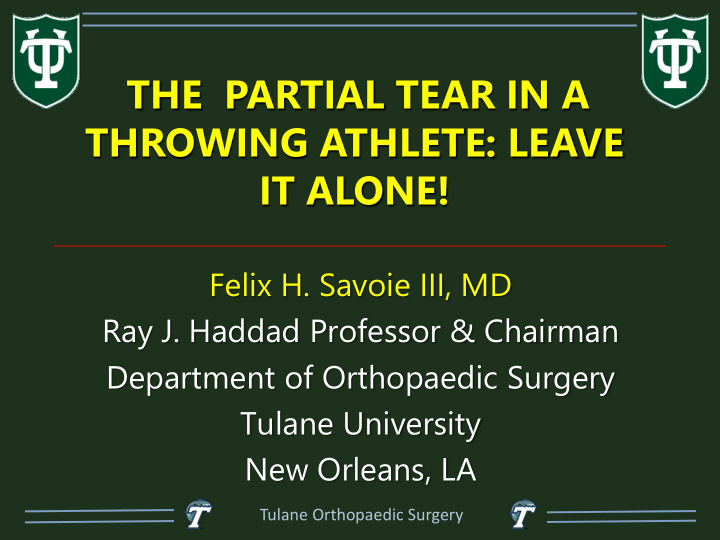



THE PARTIAL TEAR IN A THROWING ATHLETE: LEAVE IT ALONE! Felix H. Savoie III, MD Ray J. Haddad Professor & Chairman Department of Orthopaedic Surgery Tulane University New Orleans, LA Tulane Orthopaedic Surgery
COI • Royalties: none • Consultant: Smith & Nephew, Mitek, Biomet Sports, Exactech, Rotation Medical • Board of Directors: AANAEF, OLC • Research support: Mitek, Smith & Nephew Tulane Orthopaedic Surgery
DISABLED THROWING SHOULDER • Increased laxity = instability? • Scapular dyskinesis, core and hip issues? • Internal impingement with peelback SLAP or PASTA lesion: normal adaptation or too much? • Posterior band tightness: GIRD vs Tarm? Tulane Orthopaedic Surgery
LOOSE, TIGHT, OR BOTH? • In order to throw the shoulder has to have increased laxity • When does laxity become instability? • Are the changes really pathology that needs repair or normal for the activity? (Walch, D Lintner) Tulane Orthopaedic Surgery
EXPERT OPINION • Yes, instability does occur but it is “micro”- instability. Jobe, Andrews etc. • No, it is actually too tight, not loose and there is “pseudolaxity”, Morgan, Burkhart • It is both, depending on the position of the scapula? Kibler • Of course but it is normal adaptation to the activity, therefore not “instability” Lintner, Wilk, Payne etc. Tulane Orthopaedic Surgery
JOBE / ANDREWS #1 Anterior Capsular Stretching Labral tears Scapular dyskinesis Tight posterior capsule RCT Tulane Orthopaedic Surgery
MORGAN/BURKHART #1 Tightened PIGHL or loose SLAP RCT Shift center Post-sup labral tear of rotation Anterior “pseudolaxity” Tulane Orthopaedic Surgery
KIBLER #1 Scapular Dyskinesis Anterior Instability/ RCT AS Labral Tear Tight Posterior Capsule Tulane Orthopaedic Surgery
CURRENT CONCEPTS (WILK) • Laxity is necessary to • Total arc of motion throw and should be (T-arm) may be greater in the most important throwing arm concept • There are congenital • GIRD changes daily or adaptive bony –often within the changes that must be same game present to throw well • Muscular balance • Throwing shoulder is a perfect example of of the kinetic chain muscle balance essential to avoid injury Tulane Orthopaedic Surgery
CORE STRENGTH • Trunk strength and stability • Allows lower extremity power to transmit to the arm ( Kibler’s kinetic chain) • Often not well developed in children and adolescents, leading to increased injury ( one leg squat to 90) Tulane Orthopaedic Surgery
THROWING SHOULDER • Scapular position=key • Core exercises maintain scapular retraction • Scapular retraction allows maximum RC function- the partial tear is an adaptation • Proper mechanics/posture protects elbow Tulane Orthopaedic Surgery
KIBLER • Scapula position is key indicator of core strength • Easy to see visually and on physical exam Tulane Orthopaedic Surgery
THROWING SHOULDER PHYSICAL EXAM • Scapular position: @ rest and then manually retracted • Check and compare side to side motion • “Whipple” test with and without retraction to test rotator cuff balance • Dynamic Labral Shear test for instability Tulane Orthopaedic Surgery
THROWING SHOULDER: IMAGING • Regular MRI will almost always show pathology: usually SLAP tears and cuff “irregularity” • MRA more accurate • ABER position during the scan is a necessity in throwers Tulane Orthopaedic Surgery
THROWING SHOULDER: PATHOLOGY • Throwing shoulder has reset itself to adapt to the demands of the desired activity – Bone changes occur early and are normal – Increased laxity a necessity – Labral and infraspinatus degeneration are an adaptive response to internal impingement When/how do we address the painful throwing shoulder? focus should be on non-operative treatment, and with surgery “less is more” Tulane Orthopaedic Surgery
WHAT ABOUT THE INFRASPINATUS TEARS? • Debride the flaps • Do not repair to bone (Van Kleunan: AJSM) • ? Stabilize with PDS? –cannot risk shortening tendon : better to debride rather than repair in most cases • Conway/Andrews had very poor results with repair Tulane Orthopaedic Surgery
MY EXPERIENCE • Non-operative treatment is the key to all ages – Works about 70% of time • Surgery reserved for a failure of adequate physiotherapy • Pathology is age dependent and so should be treatment Tulane Orthopaedic Surgery
ALTCHEK/DINES HSS Tulane Orthopaedic Surgery
ANDREWS Tulane Orthopaedic Surgery
SHAFFER Tulane Orthopaedic Surgery
MIHATA- THAI LEE: KJOC Tulane Orthopaedic Surgery
WHAT TO DO? • 16 year old pitcher • Non op rx 15month-continued to play • Surgery peelback slap repair and PRP to Paint lesion • Post op course: immobilized 3 weeks-scapular/core POD 1; Shoulder rehab 4 wks Plyometrics and integrated rehab 8 wks – Throwing program 12 weeks – Released to play 18 weeks – Level of play increased Tulane Orthopaedic Surgery
ELITE ATHLETES 28 yo MLB Pitcher • Subluxation “normal” • Rest/rehab may be best option • Internal impingement also normal? Walch – IS tear – Peel back lesion – Posterior tightness Tulane Orthopaedic Surgery
SUMMARY • Pathology of the throwing shoulder varies widely by age • Rehabilitation of the entire kinetic change usually the preferred method of Rx • Surgery should be minimalistic-all of them are unstable, so try to fix only what “tipped them over the edge” for best results • In throwers best to leave the rotator cuff alone Tulane Orthopaedic Surgery
THANK YOU Tulane Orthopaedic Surgery
Recommend
More recommend